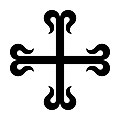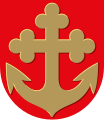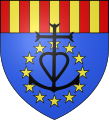A coat of arms is a heraldic visual design on an escutcheon, surcoat, or tabard. The coat of arms on an escutcheon forms the central element of the full heraldic achievement, which in its whole consists of a shield, supporters, a crest, and a motto. A coat of arms is traditionally unique to the armiger. The term "coat of arms" itself, describing in modern times just the heraldic design, originates from the description of the entire medieval chainmail "surcoat" garment used in combat or preparation for the latter.

A trident is a three-pronged spear. It is used for spear fishing and historically as a polearm. As compared to an ordinary spear, the three tines increase the chance that a fish will be struck and decrease the chance that a fish will be able to dislodge itself if struck badly. On the other hand, they are not so many as to overly reduce the spear's concentration of force for piercing.
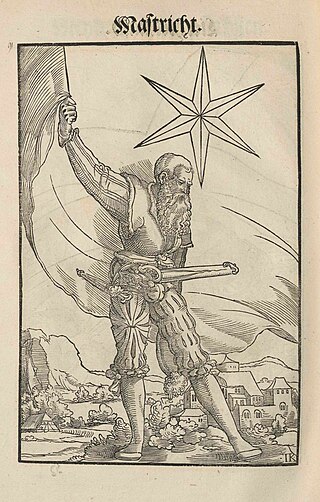
In heraldry, the term star may refer to any star-shaped charge with any number of rays, which may appear straight or wavy, and may or may not be pierced. While there has been much confusion between the two due to their similar shape, a star with straight-sided rays is usually called a mullet in English heraldry while one with wavy rays is usually called an estoile.

The globus cruciger, also known as stavroforos sphaira or "the orb and cross", is an orb surmounted by a cross. It has been a Christian symbol of authority since the Middle Ages, used on coins, in iconography, and with a sceptre as royal regalia.
Papal coats of arms are the personal coat of arms of popes of the Catholic Church. These have been a tradition since the Late Middle Ages, and has displayed his own, initially that of his family, and thus not unique to himself alone, but in some cases composed by him with symbols referring to his past or his aspirations. This personal coat of arms coexists with that of the Holy See.

A cross pattée, cross patty or Pate, or cross paty, also known as a cross formy or cross formée or Templar cross, is a type of Christian cross with arms that are narrow at the centre, and often flared in a curve or straight line shape, to be broader at the perimeter. The form appears very early in medieval art, for example in a metalwork treasure binding given to Monza Cathedral by Lombard queen Theodelinda, and the 8th-century lower cover of the Lindau Gospels in the Morgan Library. An early English example from the start of the age of heraldry proper is found in the arms of Baron Berkeley.

The eagle is used in heraldry as a charge, as a supporter, and as a crest. Heraldic eagles can be found throughout world history like in the Achaemenid Empire or in the present Republic of Indonesia. The European post-classical symbolism of the heraldic eagle is connected with the Roman Empire on one hand, and with Saint John the Evangelist on the other.
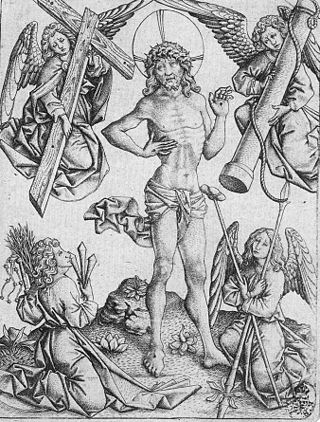
Arma Christi, or the Instruments of the Passion, are the objects associated with the Passion of Jesus Christ in Christian symbolism and art. They are seen as arms in the sense of heraldry, and also as the weapons Christ used to achieve his conquest over Satan. There is a group, at a maximum of about 20 items, which are frequently used in Christian art, especially in the Late Middle Ages. Typically they surround either a cross or a figure of Christ of the Man of Sorrows type, either placed around the composition, or held by angels.

The first coat of arms of Montreal was designed by Jacques Viger, the first mayor of Montreal, and adopted in 1833 by the city councillors. Modifications were made some one hundred five years later and adopted on 21 March 1938, and again on 13 September 2017, resulting in the version currently in use. The coat of arms was the only city emblem representing Montreal until 1981, when a stylized logo was developed for common daily use, reserving the coat of arms for ceremonial occasions.

The coat of arms of the Slovak Republic consists of a red (gules) shield, in early Gothic style, charged with a silver (argent) double cross standing on the middle peak of a dark blue mountain consisting of three peaks. Extremities of the cross are amplified, and its ends are concaved. The double cross is a symbol of its Christian faith and the hills represent three symbolic mountain ranges: Tatra, Fatra, and Matra.

The coat of arms of Denmark has a lesser and a greater version.

The Cross of Saint James, also known as the Santiago cross, cruz espada, or Saint James' Cross, is a cruciform (cross-shaped) heraldic badge. The cross, shaped as a cross fitchy, combines with either a cross fleury or a cross moline. Its most common version is a red cross resembling a sword, with the hilt and the arm in the shape of a fleur-de-lis.

In heraldry, a cross cleché flares out at the ends before tapering back to a point, in a shape resembling the bow of an old-fashioned key. An example is the Occitan cross or Cross of Toulouse in the coat of arms of the counts of Toulouse: Gules, a cross cléchée, pommetty and voided Or. Because this Occitan cross is also voided (hollow), some writers have mistakenly taken the term cléché to be a synonym of voided or to include voiding as a defining feature.

Christian symbolism is the use of symbols, including archetypes, acts, artwork or events, by Christianity. It invests objects or actions with an inner meaning expressing Christian ideas.

Coat of arms of Tallinn represents Tallinn, the capital city of Estonia.
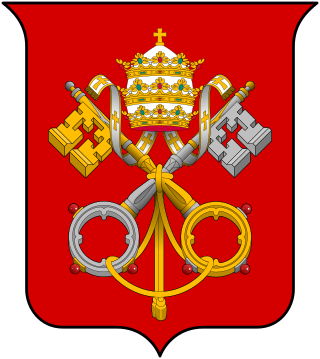
The coat of arms of the Holy See combines two crossed keys and a tiara, used as the official emblem of the Holy See, and by extension the wider Catholic Church. These forms have origins attested from the 14th century. The combination of one gold and one silver key is a somewhat later development.

The Statue of Hope is an allegorical figure that is typically a private memorial or monumental sculpture displayed in a graveyard or cemetery, often a Rural cemetery. Hope is one of the Seven Virtues of the Christian religion.

In heraldry, the term sea-lion refers to a legendary creature that has the head and upper body of a lion, but with webbed forelimbs and a fish tail. These occur most frequently as supporters, but also occur as crests and occasionally as charges. Sea-lions are frequently found in "sejant" or "sejant-erect" attitudes, but may also be found "naiant" or "assurgeant".

In addition to the three official Chaplain Corps seals for the army, navy, and air force, chaplaincies also have special seals and emblems for special schools and organizations for their chaplains, as well as a shared emblem for the "Armed Forces Chaplaincy Center" (AFCC), Fort Jackson, Columbia, South Carolina, where chaplains from all branches of the military receive their training. The original AFCC emblem had three symbols traditionally associated with learning and wisdom—a lamp, a torch and a book. A second emblem was developed by the Commandants and Commanding Officer of the three schools, in part so that it could be used on the reverse side of a two-sided AFCC challenge coin, with one symbol drawn from each of the army, navy, and Chaplain Corps emblems: a dove from the army emblem, cupped hands from the air force emblem, and an anchor from the navy emblem. In addition to using both emblems on the two sides of the AFCC coin, both designs were displayed in the AFCC lobby.
The Camargue cross, or the cross of Camargue or cross of the gardians, is a symbol for the French region of Camargue, created in 1926 by the painter Hermann-Paul at the request of Folco de Baroncelli-Javon to represent the "Camargue nation" of herdsmen and fishermen. It embodies the three theological virtues of Christianity: faith, hope, and charity.





